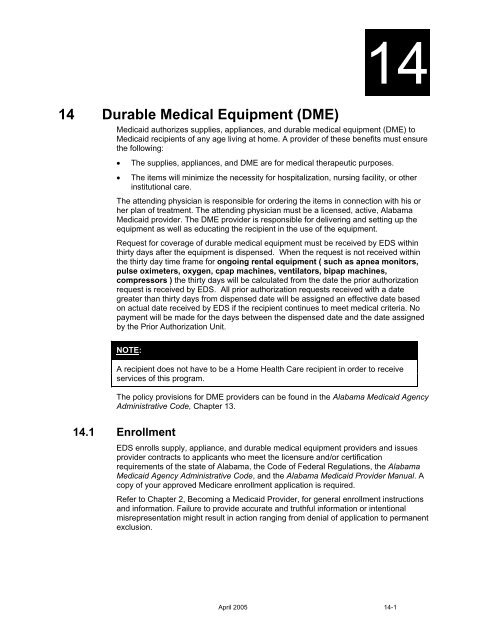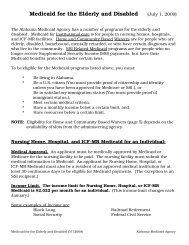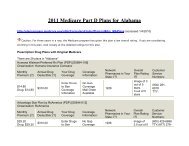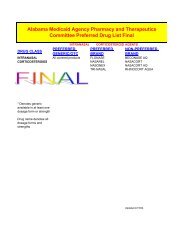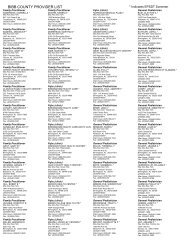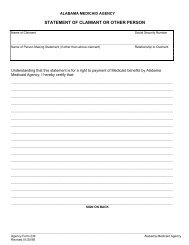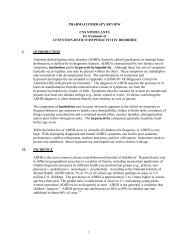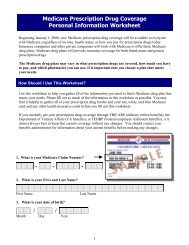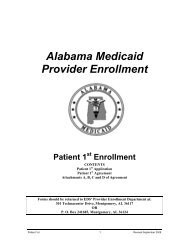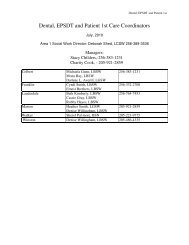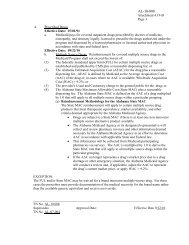Chapter 14 Durable Medical Equipment (DME)
Chapter 14 Durable Medical Equipment (DME)
Chapter 14 Durable Medical Equipment (DME)
You also want an ePaper? Increase the reach of your titles
YUMPU automatically turns print PDFs into web optimized ePapers that Google loves.
<strong>Durable</strong> <strong>Medical</strong> <strong>Equipment</strong> (<strong>DME</strong>) <strong>14</strong>Home Blood Glucose Monitor (E0607)Home blood glucose monitors will be considered for Medicaid beneficiaries diagnosedas having either Type 1, Type 2, or Gestational Diabetes Mellitus. Home blood glucosemonitors must be prescribed as medically necessary by the primary physician and priorauthorized by EDS, and at least two of the following medical criteria must be met:• Home blood glucose monitoring is required two or more times a day.• Physician identifies or diagnoses a recurrence in the recipient’s symptoms(hyperglycemia, hypoglycemia) that may be prevented, delayed, or controlled byself-monitoring the blood sugar.• Recipient has had at least one emergency room visit or one hospital admissionrelated to diabetes complications within the 12 months prior to the date of therequest.• Recipient has uncontrolled diabetes manifested by two or more fasting bloodsugars of greater than 126 mg/dl, hemoglobin Alc > 7.0%, or random blood sugar >150 mg/dl.• Recipient experiences complications resulting from poor diabetes control includingneuropathy, nephropathy, retinopathy, recurrent hyperglycemia/hypoglycemia,repeated infections or non-healing wounds, stroke, and cardiovascular disease.• Recipient has experienced two or more HbAlc levels < 4.0 % or >7.0%, at leastthree months apart.The dispensing provider must submit documentation that justifies at least two of themedical criteria above to EDS for prior authorization within thirty calendar days fromthe date the equipment was dispensed. This alone does not guarantee approval.<strong>Medical</strong> necessity must be determined by Medicaid professional staff. A review of thesubmitted documentation will determine medical necessity. The request may beapproved or denied, or additional information may be requested. Documentation mustalso include the physicians’ certification that the recipient or their caregiver is receiving,or has received, diabetes education and training for the use the glucose monitor in theappropriately prescribed manner for use in the home.Requests for Medicaid’s authorization of a replacement glucose monitor will beaccepted for review every two years from the initial physician’s certification date.Medicaid will consider requests for the exceptions from this time frame only if thereplacement is needed due to an occurrence beyond the recipient’s control. Therequest for a replacement glucose monitor must be accompanied by the documentationof the reason for the request. Negligence will not be considered a valid reason forexception.Blood Glucose Test or Reagent Strips and Lancets (A4253, A4259)Blood glucose test or reagent strips for home blood glucose monitor, along withlancets, will be considered for beneficiaries diagnosed as having either Type 1, Type 2,or Gestational Diabetes Mellitus. Blood glucose test or reagent strips must beprescribed as medically necessary by the primary physician, and at least two of thefollowing medical criteria must be met:• Home blood glucose monitoring is required two or more times a day.• Physician identifies or diagnoses a recurrence in the recipient’s symptoms(hyperglycemia, hypoglycemia) that may be prevented, delayed, or controlled byself-monitoring the blood sugar.April 2005 <strong>14</strong>-5
<strong>Durable</strong> <strong>Medical</strong> <strong>Equipment</strong> (<strong>DME</strong>) <strong>14</strong>• The recipient must be essentially bed confined.• The recipient’s physician must supervise the use of the APP in connection with thecourse of treatment.This equipment may be purchased for any qualified Medicaid recipient who meets theabove criteria. This equipment may also be rented for any recipient under the age of 21who is referred through the EPSDT Program. The information submitted must includedocumentation that the recipient meets the above medical criteria.NOTE:Alternating pressure pads are limited to one every three years for recipients whomeet the above criteria.Gel or Gel-like Pressure Pad for Mattress (E0185)Gel or gel-like pressure pads will be considered for Medicaid payment when prescribedas medically necessary by a physician. Request for coverage must be received by EDSwithin thirty calendar days after the date that the equipment was dispensed. Aneligible recipient must meet the following medical criteria:• Documentation must indicate the recipient has, or is highly susceptible to decubitusulcers.• The recipient must be essentially bed confined.• The recipient’s physician must supervise the use of the gel or gel-like pressure padin connection with the course of treatment.This equipment may be purchased for any qualified Medicaid recipient who meets theabove criteria. This equipment may also be rented for any recipient under the age of 21who is referred through the EPSDT Program. The information submitted must includedocumentation that the recipient meets the above medical criteria.NOTE:Purchase of the gel or gel-like pressure pad is limited to one every two years forrecipients who meet the above criteria.Mattress Replacement (E0271)To qualify for Medicaid reimbursement of a mattress replacement, a physician mustprescribe the equipment as medically necessary. Request for coverage must bereceived by EDS within thirty calendar days after the date that the equipment wasdispensed. An eligible recipient must meet the following medical criteria:• The patient has a safe and adequate hospital bed in his home• Documentation must be submitted showing the mattress in use is damaged andinadequate to meet the patient’s medical needs.This equipment may be purchased for any qualified Medicaid recipient who meets theabove criteria. This equipment may also be rented for any recipient under the age of 21who is referred through the EPSDT Program. The information submitted must includedocumentation that the recipient meets the above medical criteria.April 2005 <strong>14</strong>-9
<strong>Durable</strong> <strong>Medical</strong> <strong>Equipment</strong> (<strong>DME</strong>) <strong>14</strong>Trapeze Bar, AKA Recipient Helper, Attached to Bed with Grab Bar(E0910)To qualify for Medicaid reimbursement of a trapeze bar, the physician must prescribethe equipment as medically necessary for the recipient. Request for coverage must bereceived by EDS within thirty calendar days after the date that the equipment wasdispensed. The recipient must be essentially bed confined and must meet the followingdocumented conditions:• The recipient must have positioning problems. Documentation must show that therecipient has physical/mental capability of using the equipment for repositioning.• The recipient must have difficulty getting in and out of bed independently.This equipment may be purchased for any qualified Medicaid recipient who meets theabove criteria. This equipment may also be rented for any recipient under the age of 21who is referred under the EPSDT program. The information submitted must includedocumentation that the recipient meets the above medical criteria.NOTE:Purchase of the trapeze bar is limited to one per lifetime for recipients who meetthe above criteria.Nebulizer (E0570)The nebulizer is a covered service in the <strong>DME</strong> program for all recipients. The nebulizercan be provided only if it can be used properly and safely in the home. A physicianmust prescribe it as medically necessary.This equipment may be purchased for any qualified Medicaid recipient based on thecriteria listed below. This equipment may also be rented for any recipient under the ageof 21 who is referred through the EPSDT Program.The policy limiting purchase of a nebulizer (E0570) to one every two years was revised.One nebulizer may be purchased every four years for recipients if medcially necessary.Medicaid system changes were made to ensure that nebulizer purchases subject to thelimitation of one every two years has an end date of December 31, 2002 andpurchases subject to the limitation of one every four years has a begin date of January1, 2003. The system looks at claims from previous years as well as current history toensure that claims paid in 2002 will not be paid again until the four years are up.The prior authorization requirement for neulizers was dropped in June 1999,therefore, nebulizers do not require prior authorization and should not besubmitted to EDS for prior authorization.Request for consideration of payment for replacement of nebulizers due to theft or lossby disasters must be submitted with a police or fire report and a clean claim to theAlabama Medicaid Agency, 501 Dexter Avenue, Long Term Care Division,Montgomery, AL, 36103.April 2005 <strong>14</strong>-11
<strong>Durable</strong> <strong>Medical</strong> <strong>Equipment</strong> (<strong>DME</strong>)Age GroupChildren 6 years ofage or underChildren 7 through18 years of ageRecipients 18 yearsof age and aboveChildren and AdultsPurchase or Rental RequirementsPurchases require documentation of previous episodes ofsevere respiratory distress associated with one of the followingdiagnoses:• Asthma• Reactive Airway Disease• Cystic Fibrosis• Bronchiectasis• BronchospasmShort-term Rentals (6 months or less) are allowed for first timeepisodes associated with one of the above diagnoses.Supporting documentation must accompany the request.Purchases require documentation of one of the diagnoseslisted above.Documentation must also be submitted of one of the following:• The recipient has had a failed trial of a least four weeks ofanti-inflammatory drugs (for example, Cromolyn,Nedocromil, and steroids) and bronchodilators (for example,B2 adrenergics, Ipratropium) delivered by metered doseinhaler (MDI) and spacer or dry powder inhalers (DPI).• The recipient’s medical condition prevents the coordinationnecessary to effectively use an MDI and spacer or DPI (i.e.cerebral palsy, mental retardation, neuromuscularweakness, or muscle paralysis).Purchases require documentation of one of the followingdiagnoses:• Asthma• Bronchiectasis• Cystic FibrosisRecipients with a diagnosis of asthma must have documentationof one of the following:• The recipient has had a failed trial of at least four weeks ofinhaled or oral anti-inflammatory drugs and inhaledbronchodilators.• The recipient is a moderate or severe asthmatic whoserescue treatment with MDIs is insufficient to preventhospitalizations or emergency room visits (2 or more ERvisits for asthma or 1 or more hospitalizations in the past 12months).Rentals are approved only on a short-term basis (6 months orless) for acute complications of pneumonia.Purchases may be approved to deliver medications that can beadministered only by aerosol (i.e. Pulmozyme for cystic fibrosis).Must be accompanied by supporting documentation.Rentals may be approved on a short-term basis (6 months orless) to administer medications as an alternative to intravenousadministration of those drugs (for example, nebulizedtobramycin, colistin, or gentamicin). Must be accompanied bysupporting documentation.NOTE:Purchase of the nebulizer is limited to one every four years for recipients whomeet the above criteria.<strong>14</strong>-12 April 2005
<strong>Durable</strong> <strong>Medical</strong> <strong>Equipment</strong> (<strong>DME</strong>) <strong>14</strong>Iron Chelation Therapy <strong>Equipment</strong> (E0779, A4222, A4632, E1399 & E1340)Iron Chelation Therapy equipment will be considered for Medicaid payment whenprescribed as medically necessary by a physician for an eligible recipient who meetsthe following criteria:• Documentation must be submitted indicating the recipient has been diagnosed ashaving Sickle Cell Disease.• A Sickle Cell Foundation office must submit the request for the equipment.• EDS must receive a prior authorization request after obtaining the aboveinformation within thirty calendar days after the date that the equipment wasdispensed. This includes the Auto-Syringe Infusion Pump for Iron ChelationTherapy (E0779) and the Auto-Infusion Pump Repair for Iron Chelation Therapy(E1399 & E1340).Iron Chelation Therapy equipment will be purchased for any qualified Medicaidrecipient who meets the above criteria. The information submitted must includedocumentation that the recipient meets the above criteria.Augmentative Communication Devices (E2500), (E2502), (E2504), (E2506),(E2508), (E2510), (E2511), (E2512), (E2599)Augmentative Communication Devices (ACDs) are defined as portable electronic ornon-electronic aids, devices, or systems for the purpose of assisting a Medicaid eligiblerecipient to overcome or improve severe expressive speech-languageimpairments/limitations due to medical conditions in which speech is not expected to berestored. These devices also enable the recipient to communicate effectively.These impairments include but are not limited to apraxia of speech, dysarthria, andcognitive communication disabilities. ACDs are reusable equipment items that must bea necessary part of the treatment plan consistent with the diagnosis, condition or injury,and not furnished for the convenience of the recipient or his family. Medicaid will notprovide reimbursement for ACDs prescribed or intended primarily for vocational, social,or academic development/enhancement.E2500 Speech generating device digitized speech using pre-recorded messages, lessthan or equal to eight minutes recording time.E2502 Speech generating device, digitized speech using pre-recorded messagesgreater than 8 minutes, but less than or equal to 20 minutes recording time.E2504 Speech generating device, digitized speech using pre-recorded messagesgreater than 20 minutes, but less than or equal to 40 minutes recording time.E2506 Speech generating device, digitized speech using pre-recorded messagesgreater than 40 minutes recording time.E2508 Speech generating device, synthesized speech requiring message formulationby spelling and access by physical contact with the device.E2510 Speech generating device, synthesized speech permitting multiple methods ofmessage formulation and access by physical contact with the device.E2511 Speech generating software program, for personal computer or personal digitalassistant.E2512 Accessory for speech generating device, mounting system.E2599 Accessory for speech generating device not otherwise classified.April 2005 <strong>14</strong>-13
<strong>Durable</strong> <strong>Medical</strong> <strong>Equipment</strong> (<strong>DME</strong>)Scope of services includes the following elements:• Screening and evaluation• ACD, subject to limitations• Training on use of equipmentThese are inclusive in the allowable charge and may not be billed separately.NOTE:This section describes candidacy criteria, evaluation criteria, and priorauthorization and limits for ACDs.Candidacy CriteriaCandidates must meet the following criteria:AgeCandidacy CriteriaUnder age 21 • EPSDT referral by Medicaid enrolled EPSDT provider.• Referral must be within one year of application for ACD. TheEPSDT provider must obtain a referral from the Patient 1stPrimary <strong>Medical</strong> Provider where applicable• <strong>Medical</strong> condition which impairs ability to communicate asdescribed above• Evaluation required by qualified, experienced professional• Physician prescription to be obtained after the evaluation andbased on documentation contained in evaluation.Adults, age21+• Referral from a primary care physician (Patient 1 st PMP whereapplicable).• Referral must be within one year of application for ACD• <strong>Medical</strong> condition which impairs ability to communicate asdescribed above• Evaluation by required qualified experienced professionals• Physician prescription to be obtained after the evaluation andbased on documentation provided in the evaluation.Evaluation CriteriaQualified interdisciplinary professionals must evaluate the candidate. Evaluation byinterdisciplinary professionals must include a speech-language pathologist and aphysician. Qualifications for a speech-language pathologist include:• Master’s degree from accredited institution• Certificate of Clinical Competence in speech/language pathology from theAmerican Speech, Language, and Hearing Association• Alabama license in speech/language pathology• No financial or other affiliation with a vendor, manufacturer or manufacturer’srepresentative of ACDs• Current continuing education in the area of Augmentative CommunicationEvaluations by interdisciplinary professionals should also include, but may not belimited to, a physical therapist, social worker, and/or occupational therapist.A physical therapist must possess the following qualifications:<strong>14</strong>-<strong>14</strong> April 2005
<strong>Durable</strong> <strong>Medical</strong> <strong>Equipment</strong> (<strong>DME</strong>) <strong>14</strong>• Bachelor’s degree in Physical Therapy from accredited institution• Alabama license in Physical Therapy• No financial or other affiliation with a vendor, manufacturer or manufacturer’srepresentative of ACDsA social worker must possess the following qualifications:• Bachelor’s degree from accredited institution• Alabama license in Social Work• No financial or other affiliation with a vendor, manufacturer or manufacturer’srepresentative of ACDsAn occupational therapist must possess the following qualifications:• Bachelor’s degree in Occupational Therapy from accredited institution• Alabama license in Occupational Therapy• No financial or other affiliation with a vendor, manufacturer or manufacturer’srepresentative of ACDsPrior Authorization ProcessACDs and services are available only through the Alabama Medicaid prior approvalprocess. Requests for authorization must be submitted to Medicaid for review.Documentation must support that the client is mentally, physically and emotionallycapable of operating/using an ACD. The request must include documentation regardingthe medical evaluation by the physician and recipient information.<strong>Medical</strong> examination by a physician is required to assess the need for an ACD toreplace or support the recipient’s capacity to communicate. The examination shouldcover:• Status of respiration• Hearing• Vision• Head control• Trunk stability• Arm movement• Ambulation• Seating/positioning• Ability to access the deviceThe evaluation must be conducted within 90 days of the request for an ACD.April 2005 <strong>14</strong>-15
<strong>Durable</strong> <strong>Medical</strong> <strong>Equipment</strong> (<strong>DME</strong>)Medicaid requires the following recipient information with the prior authorizationrequest:TopicIdentifyinginformationSensory status(As observed byphysician)Postural, Mobility& Motor StatusDevelopmentStatusFamily/Caregiverand CommunitySupport SystemsCurrent Speech,Language andExpressiveCommunicationStatusCommunicationNeeds InventorySummary ofRecipientLimitationsACDAssessmentComponentsIdentification ofthe ACDsConsidered forRecipient-MustInclude at LeastTwo (2)Information required for the PA• Name• Medicaid RID number• Date(s) of Assessment• <strong>Medical</strong> diagnosis (primary, secondary, tertiary)• Relevant medical history• Vision• Hearing• Description of how vision, hearing, tactile and/or receptivecommunication impairments affect expressive communication(e.g., sensory integration, visual discrimination)• Motor status• Optimal positioning• Integration of mobility with ACD• Recipient’s access methods (and options) for ACD• Information on the recipient’s intellectual/cognitive/developmentstatus• Determination of learning style (e.g., behavior, activity level)A detailed description identifying caregivers and support, the extentof their participation in assisting the recipient with use of the ACD,and their understanding of the use and their expectations• Identification and description of the recipient’s expressive orreceptive (language comprehension) communication impairmentdiagnosis• Speech skills and prognosis• Communication behaviors and interaction skills (i.e. styles andpatterns)• Description of current communication strategies, including useof an ACD, if any• Previous treatment of communication problems• Description of recipient’s current and projected (for example,within 5 years) speech-language needs• Communication partners and tasks, including partner’scommunication abilities and limitations, if any• Communication environments and constraints which affect ACDselection and/or featuresDescription of the communication limitationsJustification for and use to be made of each component andaccessory requested• Identification of the significant characteristics and features of theACDs considered for the recipient• Identification of the cost of the ACDs considered for therecipient (including all required components, accessories,peripherals, and supplies, as appropriate)• Identification of manufacturer• Justification stating why a device is the least costly, equallyeffective alternative form of treatment for recipient• <strong>Medical</strong> justification of device preference, if any<strong>14</strong>-16 April 2005
<strong>Durable</strong> <strong>Medical</strong> <strong>Equipment</strong> (<strong>DME</strong>) <strong>14</strong>TopicTreatment Plan& Follow UpAdditionalDocumentationInformation required for the PA• Description of short term and long term therapy goals• Assessment criteria to measure the recipient’s progress towardachieving short and long term communication goals• Expected outcomes and description of how device willcontribute to these outcomes• Training plan to maximize use of ACD• Documentation of recipient’s trial use of equipment includingamount of time, location, analysis of ability to use• Documentation of qualifications of speech languagepathologists and other professionals submitting portions ofevaluation. Physicians are exempt from this requirement.• Signed statement that submitting professionals have nofinancial or other affiliation with manufacturer, vendor, or salesrepresentative of ACDs. One statement signed by allprofessionals will suffice.NOTE:Medicaid reserves the right to request additional information and/or evaluations byappropriate professionals.LimitsACDs including components and accessories will be modified or replaced only underthe following circumstances:• <strong>Medical</strong> Change: Upon the request of recipient if a significant medical changeoccurs in the recipient’s condition that significantly alters the effectiveness of thedevice.• Age of <strong>Equipment</strong>: ACDs outside the manufacturer’s or other applicable warrantythat do not operate to capacity will be repaired. At such time as repair is no longercost effective, replacement of identical or comparable component or componentswill be made upon the request of the recipient. Full documentation of the history ofthe service, maintenance, and repair of the device must accompany such request.• Technological Advances: No replacements or modifications will be approved basedon technological advances unless the new technology would meet a significantmedical need of the recipient which is currently unmet by present device.All requests for replacement, modification as outlined above require a new evaluationand complete documentation. If new equipment is approved, old equipment must bereturned.April 2005 <strong>14</strong>-17
<strong>Durable</strong> <strong>Medical</strong> <strong>Equipment</strong> (<strong>DME</strong>)Other InformationAdded: Priorauthorizationsfor rental…ofthe ACDdevice.TopicInvoiceTrial PeriodRepairLoss/DamageComponent /Accessory LimitsWheelchairsRequired for the PAThe prior authorization request and the manufacturer’s invoice mustbe forwarded to EDS Prior Authorization department.No communication components will be approved unless the clienthas used the equipment and demonstrated an ability to use theequipment.Prior authorization for rental may be obtained for a trial period. Thisdemonstrated ability can be documented through periodic use ofsample/demonstration equipment. Adequate supportingdocumentation must accompany the request.Prior authorizations for rental of ACD device E2510 may be approvedfor a four (4) week trial period of usage by the recipient. Themanufacturer must agree to this trial period. Medicaid will reimbursethe manufacturer for the dollar amount authorized by the Agency forthe four (4) week trial period. This amount will be deducted from thetotal purchase price of the ACD device.Repairs are covered only to the extent not covered by manufacturers’warranty. Repairs must be prior approved. Battery replacement is notconsidered repair and does not require prior authorization.Replacement of identical components due to loss or damage must beprior approved. These requests will be considered only if the loss ordamage is not the result of misuse, neglect, or malicious acts by theusers.No components or accessories will be approved that are notmedically required. Examples of non-covered items include but arenot limited to the following:• Printers• Modems• Service contracts• Office/business software• Software intended for academic purposes• Workstations• Any accessory that is not medically required.To qualify for Medicaid reimbursement of a wheelchair, the physician must prescribethe equipment as medically necessary for the recipient. Request for coverage must bereceived by EDS within thirty calendar days after the date that the equipment wasdispensed. The recipient must be essentially bed confined and must meet the followingdocumented conditions:Deleted: to Section <strong>14</strong>.5.3Added: Appendix PDeleted: Effective October1, 2000, beganreimbursingAdded: reimbursesDeleted: Medicare’sprocedure codeAdded: HCPC code• The recipient must be essentially chair confined or bed/chair confined.• The wheelchair is expected to increase mobility and independence.A standard wheelchair (procedure code E1130) should be requested unlessdocumentation supports the need for any variation from the standard wheelchair. Anexample of this variation is an obese recipient who requires the wide heavy-dutywheelchair (E1093). For a list of valid wheelchair procedure codes, refer Appendix P,Procedure Codes and Modifiers.Medicaid reimburses <strong>Durable</strong> <strong>Medical</strong> <strong>Equipment</strong> providers for Extra Heavy DutyWheelchairs. These wheelchairs accommodate weight capacities up to 600 lbs.Medicaid covers these wheelchairs as a purchase by using HCPC code K0007.<strong>14</strong>-18 April 2005
<strong>Durable</strong> <strong>Medical</strong> <strong>Equipment</strong> (<strong>DME</strong>) <strong>14</strong>Medicaid covers the other manual wheelchair base to accommodate weightcapacity of 600 pounds or greater. The other manual wheelchair base will becovered using HCPC code K0009. The wheelchair component or accessory nototherwise specified for the wheelchair will be covered using procedure code K0108(an already existing code). We will use the established prior authorization criteriafor the other manual wheelchair base, and the wheelchair component or accessorynot otherwise specified. Medicaid will require provider to submit available MSRPSfrom three manufacturers for the items. Medicaid will require weight, width anddepth specification for these items.NOTE:The provider must ensure that the wheelchair is adequate to meet the recipient’sneed. For instance, providers should obtain measurements of obese recipients toascertain body width for issuance of a properly fitted wheelchair.This equipment may be purchased for any qualified Medicaid recipient who meets theabove criteria. This equipment may also be rented for any recipient under the age of 21who is referred under the EPSDT program. The information submitted must includedocumentation that the recipient meets the above medical criteria.MOTORIZED/POWER WHEELCHAIRSThe Alabama Medicaid Agency covers motorized/power wheelchairs and to qualifyfor the motorized/power wheelchairs an individual must meet full Medicaid financialeligibility and established medical criteria. All requests for motorized/powerwheelchairs are subject to Medicaid Prior Approval provisions established by theAlabama Medicaid Agency. The patient must meet criteria applicable to manualwheelchairs pursuant to the Alabama Medicaid Agency Administrative Code Rule No.560-X-13-.17. The attending physician must provide documentation that a manualwheelchair cannot meet the individual’s medical needs, and the patient must requirethe motorized/power wheelchair for six (6) months or longer.The following are policies related to the coverage of motorized/powerwheelchairs:• Motorized/power wheelchair base codes covered are K0010, K0011, K0012 andK00<strong>14</strong>. The reimbursement for K0010, K0011, and K0012 will be based onMedicaid’s pricing file and fee schedule. Reimbursement for K00<strong>14</strong> will be basedon the Manufacturer's Suggested Retail Price (MSRP) minus 15%.• Reimbursement for wheelchair accessories using procedure codes listed inAppendix P under Wheelchair Accessories will be based on Medicaid’s pricing fileand fee schedule.• Repairs and/or replacement of parts for motorized/power wheelchairs will requireprior authorization by the Alabama Medicaid Agency. Prior authorization may begranted for repairs and replacement parts for motorized/power wheelchairs notpreviously paid for by Medicaid and those prior authorized through the EPSDTprogram. Wheelchair repairs and replacement parts for motorized/powerwheelchairs may be covered using the appropriate HCPC code listed in Section<strong>14</strong>.5.3 under Wheelchair Accessories.• Reimbursement may be made for up to one month for a rental of a wheelchairusing procedure code K0462 while patient owned equipment is being repaired.Deleted:February 1,2003, begancoverage ofAdded:coversAdded:motorized/Power, andDeleted: foradults age 21and aboveDeleted:EffectiveJune 20,2003, begancoveringAdded:coversDeleted:Section<strong>14</strong>.5.3Added:Appendix PDeleted:Accessoriesfor themotorized…per approvedwheelchairDeleted: A,must haveat least…withNRRTS/RESNADeleted: atleast oneemployee…Supplier(CRTS)Added: musthave…ofNorthAmerica(RESNA)Added: orregisteredwith…Suppliers(NRRTS).Deleted:only, whohaveemployees…provide thatare certifiedmayparticipate.April 2005 <strong>14</strong>-19
<strong>Durable</strong> <strong>Medical</strong> <strong>Equipment</strong> (<strong>DME</strong>)• Suppliers providing motorized/power wheelchairs to recipients must have at leastone employee with certification from Rehabilitation Engineering and assistiveTechnology Society of North America (RESNA) or registered with the NationalRegistry of Rehab Technology Suppliers (NRRTS). After October 1, 2004,suppliers must meet these certification requirements to providemotorized/power wheelchairs.For information regarding certification through RESNA contact: Ms. TonyaVaughn at (703) 524-6686, extension 311.The following is the process for obtaining prior approval of amotorized/power wheelchair and accessories:• The attending physician must provide the patient with a prescription for themotorized/power wheelchair.• The attending physician must provide medical documentation that describes themedical reason(s) why a motorized/power wheelchair is medically necessary. Themedical documentation should also include diagnoses, assessment of medicalneeds, and a plan of care.• The patient must choose a <strong>Durable</strong> <strong>Medical</strong> <strong>Equipment</strong> (<strong>DME</strong>) provider that willprovide the wheelchair.• The <strong>DME</strong> provider should arrange to have the Alabama Medicaid AgencyMotorized/Power Wheelchair Assessment Form 384 completed by an Alabamalicensed physical therapist who is employed by a Medicaid enrolled hospitaloutpatient department. The physical therapist’s evaluation is paid separatelyand is not the responsibility of the <strong>DME</strong> provider.• The <strong>DME</strong> provider must ensure that the prior authorization request for themotorized/power wheelchair includes the product’s model number and name, thename of the manufacturer, and a list of all wheelchair accessories with applicableprocedure codes.The <strong>DME</strong> provider will complete the Alabama Medicaid Agency Prior AuthorizationForm 342 and submit Form 384 along with medical documentation from the physicianand mail to EDS, Prior Authorization Unit, P.O. Box 244032, Montgomery,Alabama 36124-4032.NOTE:Purchase of the wheelchair is limited to one every five years for recipients whomeet the above criteria.Low Pressure and Positioning Equalization Pad for Wheelchair (E0192)(K0108)To qualify for Medicaid reimbursement of a low pressure equalization pad, theequipment must be prescribed as medically necessary for the recipient by thephysician. Requests for coverage must be received by EDS within thirty calendardays after the date that the equipment was dispensed. To qualify for Medicaidreimbursement or a Low Pressure and Positioning Equalization Pad for a wheelchair,the recipient must meet the following documented conditions:• A licensed physician must prescribe the equipment as medically necessary.<strong>14</strong>-20 April 2005
<strong>Durable</strong> <strong>Medical</strong> <strong>Equipment</strong> (<strong>DME</strong>) <strong>14</strong>• Recipient must have decubitus ulcer or skin breakdown.• Recipient must be essentially wheelchair confined.This equipment may be purchased for any qualified Medicaid recipient who meets theabove criteria. This equipment may also be rented for any recipient under the age of 21who is referred through the EPSDT Program. The information submitted must includedocumentation that the recipient meets the above medical criteria.Medicaid also reimburses <strong>Durable</strong> <strong>Medical</strong> <strong>Equipment</strong> providers for the RohoCushions for the Extra Heavy Duty Wheelchair. This wheelchair cushion is coveredas a purchase through Medicaid using Medicare’s procedure code K0108. ThisHCPC code may be used to cover wheelchair cushions for obese individuals whocould not use HCPC code E0192.Deleted: EffectiveOctober 1, 2000,began reimbursingAdded: reimbursesNOTE:Medicaid will use the established prior authorization criteria for the Extra HeavyDuty Wheelchair and Roho Cushion, but we will add weight, width and depthspecifications. Individuals approved for these items must be fitted and measured forwheelchair and cushion by the <strong>Durable</strong> <strong>Medical</strong> <strong>Equipment</strong> company providingthese services.NOTE:Purchase of a Low Pressure and Positioning Equalization Pad will be limited to oneevery two years for recipients who meet the above criteria.OxygenOxygen is necessary for life. When we breathe in, oxygen enters the lung and goes intothe blood. When the lungs cannot transfer enough oxygen into the blood to sustain life,an oxygen program may be necessary.Oxygen therapy is a covered service based on medical necessity and requires priorauthorization. Requests for coverage must be received by EDS within thirty calendardays after the oxygen equipment is dispensed. The 30 days will be calculated from thedate the prior authorization request is received by EDS. All prior authorization requestsreceived with a date greater than 30 days from dispensed date will be assigned aneffective date based on actual date received by EDS if the recipient continues to meetmedical criteria. No payment will be made for the days between the dispensed dateand the date assigned by the Prior Authorization Unit. The <strong>DME</strong> provider will be notifiedin writing of the assigned effective date and additional justification requirements ifapplicable. In order to receive a prior authorization number, forms 360 and 342 must becompleted and submitted to EDS. Oxygen therapy is based on the degree ofdesaturation and/or hypoxemia. To assess patient's need for oxygen therapy, thefollowing criteria must be met:a. The medical diagnosis must indicate a chronic debilitating medical condition,with evidence that other forms of treatment (such as medical and physical therapydirected at secretions, bronchospasm and infection) were tried without success, andthat continuous oxygen therapy is required. Oxygen will not be approved for PRNuse only.b. Recipients must meet the following criteria:April 2005 <strong>14</strong>-21
<strong>Durable</strong> <strong>Medical</strong> <strong>Equipment</strong> (<strong>DME</strong>)Added: For initialcertificationi. Adults with a current ABG with a PO2 at or below 59 mm Hg or anoxygen saturation at or below 89 percent, taken at rest, breathing roomair. If the attending physician certifies that an ABG procedure is unsafe fora patient, an oximetry for SaO2 may be performed instead. Pulse oximetryreadings on adults will be considered only in unusual circumstances.Should pulse oximetry be performed, the prescribing physician mustdocument why oximetry reading is necessary instead of arterial blood gas.ii. Recipients 20 years old or less with a SaO2 level:• For ages birth through three years, equal to or less than 94%• For ages four and above equal to or less than 89%c. The physician must have seen the recipient and obtained the ABG or SaO2 within6 months of prescribing oxygen therapy. Submission of a copy of a report frominpatient or outpatient hospital or emergency room setting will also meet thisrequirement. Prescriptions for oxygen therapy must include all of the following:i. type of oxygen equipmentii. oxygen flow rate or concentration leveliii. frequency and duration of useiv. estimate of the period of needv. circumstances under which oxygen is to be usedd. <strong>Medical</strong> necessity initial approval is an approval for no more than three months. Torenew approval, ABG or oximetry is required within the third month of the initialapproval period. Approval for up to 12 months will be granted at this time ifresulting pO2 values or SaO2 levels continue to meet criteria. If ABG or oximetry isnot obtained within the third month of the initial approval period or in the case of asubsequent recertification requests within 6 months prior to the end of the currentcertification period, approval will be granted beginning with the date of thequalifying ABG or oximetry reading.e. Criteria for equipment reimbursementi. Oxygen concentrators will be considered for users requiring one or moretanks per month of compressed gas (stationary unit). Prior approvalrequests will automatically be subjected to a review to determine if aconcentrator will be most cost effective.ii. Reimbursement will be made for portable O2 only in gaseous form.Medicaid will cover portable oxygen for limited uses such as physicianvisits or trips to the hospital. This must be stated as such on the medicalnecessity or prior approval request. Portable systems that are used on astandby basis only will not be approved. Only one portable system(E0431) consisting of one tank and up to four refills (E0443 ) permonth will be approved based on a review of submitted medicaljustification. An example of justification for refills includes, but is notlimited to, multiple weekly visits for radiation or chemotherapy.Medicaid will reimburse for only one stationary system.iii. For initial certification for oxygen the <strong>DME</strong> supplier, and itsemployees, may not perform the ABG study or oximetry analysisused to determine medical necessity.<strong>14</strong>-22 April 2005
<strong>Durable</strong> <strong>Medical</strong> <strong>Equipment</strong> (<strong>DME</strong>) <strong>14</strong>iv. Effective January 1, 2005 for recertification for oxygen only followingqualifying sleep study which allows for approval of nocturnal oxygen, the<strong>DME</strong> supplier may perform the oximetry analysis to determine continuedmedical necessity for recipients receiving nocturnal oxygen only. Aprinted download of the oximetry results must be submitted with a priorauthorization request. Handwritten results will not be accepted.Added: (iv)EffectiveJanuary 1,2005 forrecertification…will not beaccepted.NOTE:There are no restrictions related to oxygen flow rate and eligibility for oxygencoverage. The restriction is related only to the procedure codes covered.Include a copy of the EPSDT Screening and Referral form with oxygen requestsfor children under age 21. This form is used to allow additional medical necessityequipment and/or supplies to be covered beyond current limitations. Only oneportable system consisting of one tank and up to four refills per month will beapproved based on a review of submitted medical justification.Pulse Oximeter - (E0445) RHypoxia is defined as insufficient oxygenation of the blood. Pulse oximetry is a noninvasivemethod of determining blood oxygen saturation levels to assist withdetermining the amount of supplemental oxygen needed by the patient.Request for coverage of pulse oximeters must be received by EDS within thirty daysafter the equipment is dispensed. When the request is not received within the thirtydaytime frame for pulse oximeters, the thirty days will be calculated from the date theprior authorization request is received by EDS. All prior authorization requestsreceived with a date greater than thirty days from dispensed date will be assigned aneffective date based on actual date received by EDS if the recipient continues to meetmedical criteria. No payment will be made for the days between the dispensed dateand the date assigned by the Prior Authorization Unit.Pulse oximeters are a covered service for EPSDT eligible individuals who are alreadyapproved for supplemental home oxygen systems and whose blood saturation levelsfluctuate, thus requiring continuous or intermittent monitoring to adjust oxygen delivery.To receive prior authorization, submit a written request to include, but not limited to, allthe following requirements:• A completed Form 342 with required supportive documentation• Copy of EPSDT form/referral• Copy of prior approval form for home oxygen (Form 360)The use of home pulse oximetry, for pediatric patients, is considered medicallyappropriate if one of the following criteria is met in addition to the documentationrequirements in B:April 2005 <strong>14</strong>-23
<strong>Durable</strong> <strong>Medical</strong> <strong>Equipment</strong> (<strong>DME</strong>)Documentation Requirements A:1. Patient is diagnosed with a serious respiratory diagnosis and requires short-term 1oximetry to rule out hypoxemia and/or to determine the need for supplementaloxygen; or2. Patient is ventilatory dependent with supplemental oxygen required; or3. Patient has a tracheostomy and is dependent on supplemental oxygen; or4. Patient requires supplemental oxygen per Alabama Medicaid criteria (see below)and has unstable saturations 2 ; or5. Patient is on supplemental oxygen and weaning is in process.Documentation Requirements B:For those currently not on oxygen, additional medical justification may be submitted.Approval will consist of up to three months only. In addition to items a and b, thefollowing documentation is required:• Pulse oximetry evaluations. To qualify, recipients from birth to thru three yearsmust have a SaO2 equal to or less than 94%. Recipients age four and above musthave a SaO2 equal to or less than 89%. Conditions under which lab results wereobtained must be specified. When multiple pulse oximetry readings are obtainedthe qualifying desaturations must occur for five or more minutes (cumulativedesaturation time) to qualify. Pulse oximetry evaluations are acceptable whenordered and evaluated by the attending physician, and performed under his/hersupervision, or when performed by a qualified provider or supplier of laboratoryservices. A <strong>DME</strong> supplier is not a qualified provider or supplier of lab services.• Plan of care. A plan of care updated within 30 days of request must be submittedto include, at a minimum, plans for training the family. The training plan shallprovide specific instructions on appropriate responses for different scenarios, i.e.,what to do when O2 sats are below 89%.Initial approval will consist of up to 90 days only. For requests secondary to the needto determine the appropriateness of home oxygen liter flow rates, to rule out hypoxemiaand/or to determine the need for supplemental oxygen, approval will be granted for upto 30 days only. Renewal may be requested for patients already approved for oxygencoverage by the Alabama Medicaid Agency. Documentation may also include writtenor printed results of pulse oximetry readings obtained within the last month withdocumentation of condition(s) present when readings were obtained. Renewal may begranted for up to a six-month period for patients receiving oxygen coverage throughAlabama Medicaid.Qualifying Diagnoses:Lung disease, including but not limited to interstitial lung disease, cancer of the lung,cystic fibrosis bronchiectasis.1 Short-term is defined as monitoring/evaluation for up to 30 days. “Spot oximetry” is not covered underthis policy.2 Unstable saturations are documented desaturations which require adjustments in the supplementaloxygen flow rates to maintain saturation values. This should be documented to have occurred at leastonce in a 60 day period immediately preceding the request for certification/recertification.<strong>14</strong>-24 April 2005
<strong>Durable</strong> <strong>Medical</strong> <strong>Equipment</strong> (<strong>DME</strong>) <strong>14</strong>• Hypoxia related symptoms/conditions, such as pulmonary hypertension• Recurrent CHF secondary to cor pulmonale• Erythrocytosis• Sickle cell disease• Severe Asthma• Hypoplastic heart disease• Suspected sleep apnea or nocturnal hypoxia• Other diagnoses with medical justificationMedicaid Coverage for Pulse OximeterThe Pulse Oximeter must be an electric desk top model with battery backup, alarmsystems, memory and have the capacity to print downloaded oximeter readings. Thedownloads for each month of the most current certification period are required for allrecertification requests. Recertification is required until the recipient no longer meetscriteria or the device is removed from the home. This equipment will be rented for $150per month for a capped rental not to exceed $1500 ($150 per month for up to 10months). The monthly payment will include delivery, in-service for the caregiver,maintenance, repair, supplies and 24-hour service calls. If the pulse oximeter isdetermined not to be medically necessary (criteria no longer met), the oximeter will bereturned to the supplier and may be rented to another client who meets criteria forpulse oximeter. The Medicaid Agency will pay for repair of the pulse oximeter after theinitial 10 months only to the extent not covered by the manufacturer’s warranty.Repairs must be prior authorized and the necessary documentation to substantiate theneed for repairs must be submitted to EDS who will forward this information to theAlabama Medicaid Agency Prior Authorization Unit. Replacement of the pulse oximeterwill require prior authorization and will be considered after three (3) years based uponthe review of submitted documentation. If the replacement is due to disaster or damagewhich is not the result of misuse, neglect or malicious acts by users, then requests forconsideration of payment for replacement equipment must be submitted to theAlabama Medicaid Agency, Long Term Care Division with a police report, fire report orother appropriate documentation. In addition, one reusable probe per recipient peryear will be allowed after the initial 10 months capped rental period.LimitationsDiagnoses not covered:• Shortness of breath without evidence of hypoxemia• Peripheral Vascular Disease• Terminal illnesses not affecting the lungs, such as cancer not affecting thelungs or heart disease with no evidence of heart failure or pulmonaryinvolvement.Pulse oximeter requests for renewal will not be approved after the initialmonitoring/evaluation period for those recipients not meeting criteria for oxygencoverage. Spot oximetry readings are non-covered service under the <strong>DME</strong>program.Coverage of supplies for the Pulse OximeterApril 2005 <strong>14</strong>-25
<strong>Durable</strong> <strong>Medical</strong> <strong>Equipment</strong> (<strong>DME</strong>)Supplies for the Pulse Oximeter will only be paid for by Medicaid aftercompletion of the ten month rental period.Non disposable probes may be used for children whose weight is greaterthan 20 kilograms (2.2 kilograms = 1 pound) or greater than 44 pounds.Children 10 to 11 years old can use non disposable probes.A4606 - non disposable probe is limited to one per year per recipient.A4606 – disposable probe is limited to two per month per recipient.Volume Ventilator – Stationary or Portable (E0450-R) with backup ratefeature used with invasive interface.Volume Ventilator – Stationary or Portable (E0461-R) with backup ratefeature used with non- invasive interface.A ventilator is covered for EPSDT referred recipients. A physician must prescribe it asmedically necessary. Request for coverage of ventilators must be received by EDSwithin thirty calendar days after the equipment is dispensed. When the request is notreceived within the thirty day time frame for ventilators the thirty days will becalculated from the date the prior authorization request is received by EDS. All priorauthorization requests received with a date greater than thirty days from dispenseddate will be assigned an effective date based on actual date received by EDS if therecipient continues to meet medical criteria. No payment will be made for the daysbetween the dispensed date and the date assigned by the Prior Authorization Unit. Therecipient must meet the following conditions:• The recipient is unable to maintain respiration spontaneously.• The recipient is unable to maintain safe levels of arterial carbon dioxide or oxygenwith spontaneous breathing.• The recipient has a medical condition that requires mechanically assistedventilation that is appropriate for home use without continuous technical orprofessional supervision.The appropriate EPSDT Screening Referral form must be attached to the priorauthorization request. The information submitted must include documentation that therecipient meets the above criteria.Home Phototherapy (S9120)Home phototherapy is a covered service with prior authorization in the <strong>DME</strong> Programfor EPSDT referred recipients. To administer the treatment of phototherapy safely andproperly in the home, an attending physician must prescribe it as medically necessaryfor hyperbilirubinemia. EDS must receive requests for coverage within thirty calendardays after the first home phototherapy treatment.The attending physician is responsible for determining the length of time the infant is toreceive the therapy based on serum bilirubin levels and clinical condition of the infant.Treatment of bilirubin levels of 12.0 or less will not be covered.Providers of home phototherapy must meet the following:• Be enrolled as a Medicaid <strong>DME</strong> provider<strong>14</strong>-26 April 2005
<strong>Durable</strong> <strong>Medical</strong> <strong>Equipment</strong> (<strong>DME</strong>) <strong>14</strong>• Have currently licensed registered nurses to perform the home visits andassociated professional services• Submit in writing the following information on each registered nurse who will beperforming nursing visits:−Name− Registered Nurse’s license number with effective date and expiration date• Submit in writing bilirubin levels and treatment start and stop datesProcedure code S9120 is established for home phototherapy with a global fee per daythat includes equipment, nursing visits, and collection of lab work.Incontinence Products (Disposable Diapers) (A4529), (A4530), (A4521),(A4522), (A4523), (A4524).The procedure codes listed above will be honored for priorauthorizations approved for dates of services extending into year2004. Prior authorizations (for diapers) requested on or after January1, 2005 will be considered using procedure codes T4521, T4522,T4523, T4524, T4529, and T4530.These incontinence products (disposable diapers) require prior authorization.Medicaid will consider payment of disposable diapers when referred as medicallynecessary from an EPSDT screen and the criteria below are met:1. Recipient must be at least 3 years old;2. Patient must be non-ambulatory or minimally ambulatory;3. Patient must be medically at risk for skin breakdown, which is defined asmeeting at least two of the following:a) Unable to control bowel or bladder functions,b) Unable to utilize regular toilet facilities due to medical conditionc) Unable to physically turn self or reposition self,d) Unable to transfer self from bed to chair or wheelchair without assistance.A4521 - T4521 Adult-sized incontinence product, diaper, smallA4522 - T4522 Adult-sized incontinence product, diaper, mediumA4523 - T4523 Adult-sized incontinence product, diaper, largeA4524 - T4524 Adult-sized incontinence product, diaper extra largeA4529 - T4529 Child-sized incontinence product, diaper small/mediumA4530 - T4530 Child-sized incontinence product, LargeApnea Monitor (E0619)The apnea monitor is a covered service with prior authorization in the <strong>DME</strong> program forEPSDT referred recipients. The apnea monitor can be provided only if it can be usedproperly and safely in the home and if it has been prescribed as medically necessaryby a physician. Request for coverage of apnea monitors must be received by EDSwithin thirty calendar days after the equipment is dispensed. When the request is notDeleted:THESEPROCEDURECODES..SERVICE APRIL 1,2004Added: Theprocedurecodeslisted…T4529,and T4530.Added:-T4521-T4522-T4523-T4524-T4529-T4530April 2005 <strong>14</strong>-27
<strong>Durable</strong> <strong>Medical</strong> <strong>Equipment</strong> (<strong>DME</strong>)received within the thirty day time frame for apnea monitors the thirty days will becalculated from the date the prior authorization request is received by EDS. All priorauthorization requests received with a date greater than thirty days from dispenseddate will be assigned an effective date based on actual date received by EDS if therecipient continues to meet medical criteria. No payment will be made for the daysbetween the dispensed date and the date assigned by the Prior authorization Unit.To qualify for the placement of an apnea monitor and Medicaid reimbursement for themonitor, the recipient must meet/have documentation of at least one of the following(Infants are defined as less than or equal 12 months of age):• Apnea that lasts 20 or more seconds that is associated with baby’s color changingto pale, purplish or blue, bradycardia (heart rate below 80 beats per minute), babychoking or gagging that requires mouth-to-mouth resuscitation or vigorousstimulation documented by medical personnel (documented pathologic apnea).• Pre-term infants with periods of pathologic apnea• Sibling of SIDS victim• Infants with neurological conditions that cause central hypoventilation• Infants or children less than two years of age with new tracheostomies(tracheostomy within the last 60 days)The following must also be included:• Documentation from the physician with a patient specific plan of care, proposedevaluation and intervention to include length of time of use each day, anticipatedreevaluation visits/intervals, additional therapeutic interventions appropriate fordiagnosis/cause of apnea• Documentation of counseling to parents must include the understanding thatmonitoring cannot guarantee survival• Documentation of parental training and demonstration of proficiency in CPR andresuscitation methodsApproval is for three (3) months only.Renewal criteria must include the following:• A copy of nightly monitor strips or monthly download is required as documentationof pathologic apnea or bradycardia for the past three months.• A letter from the physician with patient-specific plan of care to justify the medicalnecessity for continued use of monitor at each recertification period.Discontinuation Criteria include:• Apparent Life-Threatening Event (ALTE) infants that have had two to three monthsfree of significant alarms or apnea.• The provider must check for recipient compliance (i.e. documentation via downloadmonthly or through nightly strips). The monitor will be discontinued withdocumentation of non-compliance. Non-compliance is defined as failure to use themonitor at least 80% of each certification period.• Sibling of SIDS victim who is greater than six months of age<strong>14</strong>-28 April 2005
<strong>Durable</strong> <strong>Medical</strong> <strong>Equipment</strong> (<strong>DME</strong>) <strong>14</strong>• Tracheostomy recipients greater than two years of ageEffective September 2001, before an Apnea Monitor is provided to a Medicaidrecipient, it is a Medicaid requirement that the parent/caregiver has documentationshowing that they have had CPR training and demonstrated proficiency in CPR andresuscitation methods. The staff providing CPR training must have alicense/certification to provide such training. Provider Notice 99-13, reflecting theamended Apnea Monitor policy was mailed to providers in August of 1999. Theeffective date of this provider notice was September 1, 1999.The statement listed below is information used to support the revision to the ApneaMonitor coverage policy related to parents/caregivers having CPR training. Thisinformation was taken from an article entitled “Infantile Apnea and Home Monitoring.”This article was published in the National Institute of Health Consensus DevelopmentConference Statement."All families who have babies with Apnea are encouraged to be trained in infantcardiopulmonary resuscitation (CPR) before the baby is discharged from the hospital.Although it is unlikely that you will ever have to use CPR, it is best that you beprepared." It is the <strong>DME</strong> provider’s responsibility to ensure that parents provide themwith documentation of CPR training. This documentation must show proficiency in CPRand resuscitation methods. It is not the provider’s responsibility to provide CPR trainingto the parents. However, the provider may direct the parents to agencies such as theRed Cross, Fire Departments, etc., where CPR training is provided. If a priorauthorizationrequest for an Apnea Monitor is submitted to Medicaid without this requesteddocumentation, the request will be denied. The Prior Authorization Unit will request theprovider to resubmit the prior authorization request with the needed documentation. Noprior authorizations will be approved without this documentation.NOTE:A caregiver trained and capable of performing Cardiopulmonary Resuscitation(CPR) must be available in the home. Documentation must be provided.When submitting a prior approval request for Medicaid’s authorization of an apneamonitor for a sibling of a SIDS victim, use the diagnosis code V201. <strong>DME</strong>providers should use V201 only for a recipient who is a sibling of a SIDS victim.Do not use diagnosis code 7980. The clinical statement on PA Form 342 mustinclude documentation from the physician supporting the recipient’s diagnosis of‘Sibling of SIDS victim.’<strong>14</strong>.2.3 Non-covered Items and ServicesMedicaid does not cover the following types of items:• Items of a deluxe nature• Replacement of usable equipment• Items for use in hospitals, nursing facilities, or other institutions• Items for recipient’s comfort or the caring person's convenience• Items not listed as covered by MedicaidApril 2005 <strong>14</strong>-29
<strong>Durable</strong> <strong>Medical</strong> <strong>Equipment</strong> (<strong>DME</strong>)• Rental of equipment, with exceptions noted below− EPSDT referred services− Medicare crossovers− Certain intravenous therapy equipment− Short term use due to institutionalization− Short term use due to death of a recipientDeleted:Section<strong>14</strong>.5.3Added:Appendix P<strong>14</strong>.3 Prior Authorization and Referral RequirementsCertain <strong>DME</strong> requires prior authorization. Please refer to Appendix P, Procedure Codesand Modifiers, for items that require prior authorization from Medicaid. Payment will notbe made for these procedures unless the prior authorization request is received withinthirty calendar days after the service is provided.NOTE:Prior authorization is not a guarantee of payment. The authorization number doesnot guarantee recipient eligibility at the time the equipment is dispensed. Theprovider is responsible for verifying recipient’s eligibility.When filing claims for recipients enrolled in the Patient 1 st Program, refer to <strong>Chapter</strong> 39to determine whether your services require a referral from the Primary <strong>Medical</strong> Provider(PMP).All requests for prior approval should be initiated and signed by the attending physicianand must document medical necessity. Requests may be sent electronically using theEDS Provider Electronic Solution software or mailed in hardcopy to the PriorAuthorization Unit, P.O. Box 244032, Montgomery, Alabama 36124-4032. The PA Unitat Medicaid will approve, deny, or return the request. EDS will return any requestscontaining missing or invalid information. Please see <strong>Chapter</strong> 4, Obtaining PriorAuthorization, for additional information.<strong>14</strong>.3.1 Authorization for <strong>Durable</strong> <strong>Medical</strong> <strong>Equipment</strong>Provider must have a prescription on file from the attending physician that a specificcovered item of durable medical equipment is medically necessary for use in therecipient's home prior to completing the Alabama Prior Review and AuthorizationRequest form.Prior authorization requests for purchase, rental, or re-certification of <strong>DME</strong> must bereceived by Medicaid's fiscal agent within thirty calendar days of the signature datethe equipment was dispensed. Time limits for submitting requests for services andresubmitting additional information are as follows:• All prior authorization requests for the purchase of <strong>DME</strong> received beyond thirtycalendar days after equipment is provided will be denied.• All prior authorization requests for certification of rental services received beyondthirty calendar days of beginning services will be authorized for reimbursementeffective the date of receipt at EDS.<strong>14</strong>-30 April 2005
<strong>Durable</strong> <strong>Medical</strong> <strong>Equipment</strong> (<strong>DME</strong>) <strong>14</strong>• All prior authorization requests for re-certifications of <strong>DME</strong> rental services must besubmitted to EDS within thirty calendar days of the re-certification date.Completed re-certifications received beyond the established time limit will beauthorized for reimbursement effective the date of receipt at EDS.Medicaid will review the request and assign a status of approved, denied, orsuspended. Providers are sent approval letters indicating the ten-digit PA number thatshould be referenced on the claim form for billing. Providers and recipients will also benotified on denied requests.<strong>DME</strong> Review CriteriaMedicaid reviews all <strong>DME</strong> prior authorization requests for the following:• Medicaid eligibility• Medicare eligibility• <strong>Medical</strong> necessity• Therapeutic purpose for use of equipment in the recipient’s home• Referral through the Sickle Cell Foundation, when appropriateAlthough equipment prescribed by the physician may be on the list of covered items,Medicaid will determine to what extent it would be reasonable for Medicaidreimbursement. <strong>Equipment</strong> may be authorized when it is expected to make a significantcontribution to the treatment of the recipient’s injury or illness or to improve his physicalcondition. <strong>Equipment</strong> will be denied if it is disproportionate to the therapeutic benefits ormore costly than a reasonable alternative.In the event Medicaid receives an authorization form from more than one providerprescribing the same item for a recipient, Medicaid will consider the authorization formreceived first.Disposition of <strong>Equipment</strong>The recipient or caregiver should contact the Alabama Medicaid Agency, <strong>DME</strong>Program, when the need for the equipment no longer exists. The <strong>DME</strong> provider shouldnot take back equipment from recipients or caregivers that was purchased by Medicaid.The provider should have the recipient or caregiver call the <strong>DME</strong> Program at 1-800-362-1504 when the equipment is no longer being used or needed.<strong>14</strong>.3.2 EPSDT Program ReferralsThe Omnibus Budget Reconciliation Act of 1989 expanded the scope of the Early andPeriodic Screening, Diagnosis, and Treatment (EPSDT) Program for Medicaidrecipients under age 21. Effective October 1, 1990, Medicaid began prior authorizingcertain approved medical supplies, appliances, and durable medical equipmentprescribed as a result of an EPSDT screening to treat or improve a defect, an illness, ora condition.The Alabama Medicaid Agency EPSDT Referral for Services form (Form 167) orPatient 1 st EPSDT Referral for Services form (Form 345) as applicable, and anysupporting documentation must be sent to EDS, Prior Authorization Unit, for review.Complete documentation describing how prescribed items will treat or improve acondition must be included on Form 167 or 345. Indicate prescribed items andappropriate procedure codes, and units billed in blank areas on the form.April 2005 <strong>14</strong>-31
<strong>Durable</strong> <strong>Medical</strong> <strong>Equipment</strong> (<strong>DME</strong>)Deleted:motorized/powerAdded: EPSDT referredspecializedDeleted: must have atleast…withNRRTS/RESNA.Added: must beregistered…of NorthAmerica (RESNA).Deleted: have at leastone…of North America(RESNA).Deleted: After October1, 2004…mayparticipate.Requests for EPSDT-referred specialized wheelchair systemsRequests for EPSDT-referred specialized wheelchair systems must be sent hard copy.Medicaid uses Medicare-based allowables for EPSDT-referred wheelchair systems. Ifno Medicare price is available, reimbursement rates established by Medicaid forEPSDT-referred wheelchair systems are based on a discount from ManufacturersSuggested Retail Price (MSRP) instead of a "cost-plus" basis.Providers are required to submit available MSRPs from three manufacturers forwheelchair systems (excluding seating system and add-on products) appropriate forthe individual's medical needs.Requests submitted with fewer than three prices from different manufacturers mustcontain documentation supporting the appropriateness and reasonableness ofrequested equipment for a follow-up review by Medicaid professional staff. Providermust document non-availability of required MSRPs to justify not sending in three prices.The established rate will be based on the MSRP minus the following discounts:• Manual Wheelchair Systems - 20% discount from MSRP• Power Wheelchair Systems - 15% discount from MSRP• Ancillary (add-on) products - 20% discount from MSRPSuppliers requesting approvals for medical items must provide Medicaid with anexpected date of delivery.For medical items approved based on medical necessity, Medicaid will indicate the timeframe allowed for providers to dispense equipment on the approval letter.When a provider is unable to dispense equipment within the time frame specified onthe approval letter, an extension may be requested with written justification as to thespecific reason(s) why the equipment cannot be supplied in a timely manner. Allrequests for extensions must be submitted to Medicaid prior to the expiration dateindicated on the approval letter. Medicaid will cancel approvals for medical items thatare not dispensed in a timely manner when there is no justifiable reason for delay.The Medicaid screening provider and recipient will be notified when an approvedrequest for equipment is canceled due to provider noncompliance and the recipient willbe referred to other Medicaid providers to obtain medical items.A supplier providing EPSDT referred specialized wheelchair systems to recipients mustbe registered with the National Registry of Rehab Technology Suppliers (NRRTS) orhave certification from Rehabilitation Engineering and Assistive Technology Society ofNorth America (RESNA).<strong>14</strong>.4 Patient 1st ReferralsWhen filing claims for recipients enrolled in the Patient 1 st program, refer to <strong>Chapter</strong> 39,Patient 1 st Billing Manual to determine whether your services require a referral from thePrimary <strong>Medical</strong> Provider (PMP).<strong>14</strong>.5 Cost-Sharing (Copayment)Medicaid recipients are required to pay and suppliers are required to collect thedesignated copay amount for the rental/purchase of services, supplies, appliances, andequipment, including crossovers. The copayment does not apply to services provided<strong>14</strong>-32 April 2005
<strong>Durable</strong> <strong>Medical</strong> <strong>Equipment</strong> (<strong>DME</strong>) <strong>14</strong>for pregnant women, recipients less than 18 years of age, emergencies, surgical fees,and family planning.The Medicaid <strong>DME</strong> Program requires copayment at the following rates:Item<strong>Durable</strong> <strong>Medical</strong> <strong>Equipment</strong>, includingcrossoversSupplies and Appliances, includingcrossoversIron Infusion Pump RepairCopay Amount$3.00 for each item$3.00 for items costing $50.01 or more$2.00 for items costing $25.01-$50.00$1.00 for items costing $10.01-$25.00$.50 for items costing $10.00 or less$3.00 for each Prior Authorization (PA)NumberThe provider may not deny services to any eligible Medicaid recipient because of therecipient’s inability to pay the cost-sharing amount imposed.<strong>14</strong>.6 Completing the Claim FormTo enhance the effectiveness and efficiency of Medicaid processing, providersshould bill Medicaid claims electronically.<strong>DME</strong> providers who bill Medicaid claims electronically receive thefollowing benefits:• Quicker claim processing turnaround• Immediate claim correction• Enhanced online adjustment functions‣ Electronicclaimssubmission cansave you timeand money.The systemalerts you tocommon errorsand allows youto correct andresubmitclaims online.• Improved access to eligibility informationRefer to Appendix B, Electronic Media Claims Guidelines, for more information aboutelectronic filing.NOTE:When filing a claim on paper, a CMS-1500 claim form is required. Medicarerelatedclaims must be filed on the <strong>Medical</strong> Medicaid/Medicare-related ClaimForm.Refer to <strong>Chapter</strong> 5, Filing Claims, for general claims filing information and instructions.<strong>14</strong>.6.1 Time Limit for Filing ClaimsMedicaid requires all claims for <strong>DME</strong> to be filed within one year of the date of service.Refer to Section 5.1.5, Filing Limits, for more information regarding timely filing limitsand exceptions.<strong>14</strong>.6.2 Diagnosis Codes<strong>DME</strong> providers may bill diagnosis code V729 on hard copy and electronicallysubmitted claims.April 2005 <strong>14</strong>-33
<strong>Durable</strong> <strong>Medical</strong> <strong>Equipment</strong> (<strong>DME</strong>)Added:Appendix PDeleted:Section<strong>14</strong>.5.3<strong>14</strong>.6.3 Procedure Codes and ModifiersThe medical supplies and appliances listed in Appendix P are available to eligibleMedicaid recipients for use in their homes as prescribed by the attending physicianand dispensed by a Medicaid contract provider.For a complete listing of procedure codes and modifiers refer to Appendix P:<strong>Durable</strong> <strong>Medical</strong> <strong>Equipment</strong> (<strong>DME</strong>) Procedure Codes and Modifiers.<strong>14</strong>.6.4 Place of Service CodesThe following place of service code applies when filing claims for <strong>DME</strong>:POS Code Description12 Home<strong>14</strong>.6.5 Required AttachmentsTo enhance the effectiveness and efficiency of Medicaid processing, your attachmentsshould be limited to claims with third party denials.NOTE:When an attachment is required, a hard copy CMS-1500 claim form must be submitted.Refer to Section 5.7, Required Attachments, for more information on attachments.<strong>14</strong>.7 For More InformationThis section contains a cross-reference to other relevant sections in the manual.ResourceWhere to Find ItCMS-1500 Claim Filing Instructions Section 5.2<strong>Medical</strong> Medicaid/Medicare-related Claim Filing Section 5.6.1InstructionsElectronic Media Claims (EMC) SubmissionAppendix BGuidelinesAVRS Quick Reference GuideAppendix LAlabama Medicaid Contact InformationAppendix N<strong>DME</strong> Procedure Codes and ModifiersAppendix P<strong>14</strong>-34 April 2005
<strong>Durable</strong> <strong>Medical</strong> <strong>Equipment</strong> (<strong>DME</strong>) <strong>14</strong><strong>14</strong>.8 Local Code Crosswalk InformationNOTE:Use “Local” procedure codes for dates of services through 12/31/03. Use HCPCSprocedure code, with modifier(s) if applicable, for dates of service 01/01/04 andthereafter.“Local” Codethru 12/31/03HCPCS-Modifier(s)Beginning01/01/04DescriptionZ5117 E1050 Reclining Wheelchair, with fixed arms, swingawaydetachable foot restsZ5119 A4628 Catheters, suctionZ5120 A4625 Tracheostomy Tray (New Trach)Z5120 A4629 Tracheostomy Tray (established Trach)Z5121 A4622 Tracheostomy TubesZ5122 E0280 Hospital Crib w/ MattressZ5124 E1037 Transport chair, pediatric sizeZ5129 E1091 Narrow wheelchair, w/detachable arms, swingawaydetachable foot restsZ5133 E1091 Junior sized standard wheelchairZ5134 E1091 Child's standard wheelchairZ5220 E0779 Auto-syringe infusion pump for iron chelationtherapyZ5221 A4222 Infusion tubing for iron chelation therapyZ5222 A4632 Batteries (5.6 volt) for iron chelation therapyZ5223 E1399, E1340 Auto-syringe infusion pump repair for ironchelation therapyZ5311 A4335 Catheter Care KitZ5313 99503 Respiratory Therapist VisitZ53<strong>14</strong> A9900 Primary Surgical Dressing KitApril 2005 <strong>14</strong>-35
<strong>Durable</strong> <strong>Medical</strong> <strong>Equipment</strong> (<strong>DME</strong>)“Local” Codethru 12/31/03HCPCS-Modifier(s)BeginningDescriptionAdded: (A9999is to beused…as aMedicaidauditing tool.01/01/04Z5315 A9999 IV Administration Kit. (A9999 is to be used forsupplies in the IV Administration kit. Recipient’sfile should have an itemized listing of allsupplies billed with usual and customarycharges billed for each supply. This will be usedas a Medicaid auditing tool.)Speechgeneratingsoftwareprogram, forpersonalcomputer orpersonaldigitalassistant.E2500E2508E2510E2511E2512E2502E2504E2506E2599Speech generating device, digitized speech,using pre-recorded messages, less than orequal to eight minutes recording timeSpeech generating device, synthesized speech,requiring message formulation by spelling andaccess by physical contact with the deviceSpeech generating device, Synthesized speechpermitting multiple methods of messageformulation and multiple methods of deviceaccessSpeech generating software program, forpersonal computer or personal digital assistantAccessory for speech generating device,mounting system.Speech generating device, digitized speechusing pre-recorded messages greater than 8minutes but less than 20 minutes recordingtime.Speech generating device, digitized speechusing pre-recorded messages greater than 20minutes, but less than or equal to 40 minutesrecording time.Speech generating device, digitized speechusing pre-recorded messages greater than 40minutes recording time.Accessory for speech generating device, nototherwise classified.Z5439 E1220 <strong>DME</strong> - Customized Wheelchair<strong>14</strong>-36 April 2005


